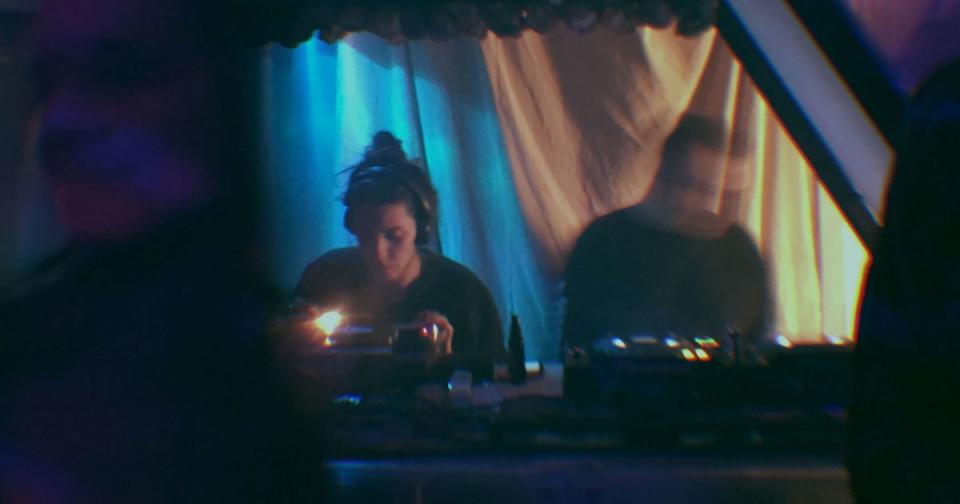Meet the Reformed Argentine Club Kid Making Zines a Fashion Statement
I’m curled up in a ball, listening to The Cure’s Disintegration in a room full of giant hanging plants and goths wearing black Buffalo Londons. It’s a profoundly rainy March afternoon in Ridgewood, Queens, but the way the light pours in through the huge industrial windows, it could maybe be early summer. I’m at Nowadays, a nightclub that, once a month, comes alive during the day for Classic Album Sundays, which is exactly what it sounds like: enthusiasts sit in a room and listen to a beautiful album on some extraordinarily good hi-fi equipment. This Sunday, the speakers blare Robert Smith’s iconically macabre 1989 record. In the front of the room next to the turntable stands a woman wearing an all-black outfit that most notably includes a perfect pair of black Acne jeans.
Her name is Barbie Bertisch, and in addition to running this event, she works in fashion as a project manager at the branding studio High Tide and plays in a band. She also cocurates the zine Love Injection, which celebrates New York and its history, with her partner, Paul Raffaele. Found at record stores across the country, the zine is relatively freeform and is composed of stories ranging from interviews with New York dance-music icons to club chart listings to essays on repealing the city’s Cabaret Law and more. The result is a truly special print artifact that captures what it is like to live and dance in New York City.

Bertisch is someone with a creative vision that spans the entirety of New York’s microcosm of the hi-fi scene, which is devoted to finding and sharing audio formats of the highest quality. When I see her at Nowadays, she spends time telling the audience about the physical weight of the vinyl pressing we are listening to. She goes into even more detail when she explains the acoustics of the space and why she selected the turntable the record sits on. Bertisch explains all of this with diligence and doesn’t make assumptions about our prior knowledge of hi-fi going into the afternoon, which was crucial. Once the record starts playing, I think about all of the different elements of audio in a way I never have before. I love good sound as much as the next person, but after hearing Bertisch speak, it feels as if the walls are pulsating. I can feel the bass in my fingertips. When I lie down on the club’s bleachers, the synthesizer tones sound as if they are gilded. Robert Smith’s voice takes on a whole new level of viscosity when I hear it seep through the speakers that fill the room.
Bertisch could very well be the spokesperson for this way of publicly experiencing music at the highest caliber. She easily convinces listeners that great audio is an underappreciated art form, worthy of displaying its greatness through every possible medium. I first came into contact with Bertisch through a friend who works at The Lot Radio in Greenpoint, Brooklyn, where Bertisch and Raffaele also happen to regularly play sets. As a pretty huge doofus when it comes to good audio and weird sounds, I figured Bertisch would be someone I’d share a lot in common with. When I found out she also happened to have a fashion background, the idea solidified in my mind that I needed to find out more about what she does and how all of the parts of her life coalesce.
Music and fashion enjoy a notoriously symbiotic relationship, and Bertisch’s life and work encapsulate that union. A few days after Nowadays, Bertisch and I meet up at the Strand Book Store in Union Square and walk through the stacks to chat. It’s pretty packed for a Wednesday night, but we manage to find a nook off to the side and begin to discuss music and its intersection with style, as well as Bertisch’s personal relationship to New York as an Argentinian expat and a reformed club kid. First exposed to the major fashion houses of the late aughts on a trip to Europe, Bertisch quickly fell in love with Hussein Chalayan, Nicolas Ghesquière, and Raf Simons. Before she knew it, she was on her way to design school in Miami.
It was there, by the sea, that she started partying and quickly discovered the joy of the dance floor and its role in shifting personal aesthetics. “Partying added a layer of music meets fashion meets all these sort of interdisciplinary things,” she says. “I don’t know if I would’ve had that curiosity thing explored otherwise.” Bertisch’s late adolescence happened to coincide with electroclash, a genre that is a blend of heavily percussive electronics and sing-spoken vocals. Her days in the club were molded by this boiling point in independent music’s then-zeitgeist.
Instead of the Fila sneakers and tiny shades of today’s club kids, Bertisch found her dance floor style in the form of “bangs, jet-black hair, cut up tank tops, and weird sunglasses,” she shares. But But this is all in the past; Bertisch's choppy side bangs are long gone. She still goes out to parties in New York, but her relationship to club life has changed, and so has her style. Where, in her late adolescence, the relationship between her personal style and the music she listened to was directly linked to prevailing aesthetics of club culture at the time, her approach to getting dressed today is all about the uniform.

Right now, style is her quotidian armor. “I’m a fan of systems, and a uniform, and so that’s kind of like how I think about day-to-day style,” she says. When I ask her later what that uniform looks like, she explains with amazing specificity:
“There’s a black pair of perfectly fitting skinny jeans, and a white pair, and a blue pair. Ideally raw denim. Then there’s the perfect white T-shirt, the perfect T-shirt in white and black, and some sort of tan color there. Then there’s [the] perfect leather jacket. Then there’s a perfect bomber and the perfect shearling coat, then there’s the perfect peacoat and the perfect overcoat. Then there’s the perfect pair of white sneakers, then the perfect pair of Chelsea boots, and maybe stilettos,” she explains to me with a bit of a laugh. At the end of the day, though, her style comes down to being authentic, wearing clothing that fit impeccably and drawing inspiration from stylish musicians like Patti Smith, Nico, and Cosey Fanni Tutti.
Music and fashion have long coexisted with a great degree of harmony, and Bertisch’s life is a great example of this duality. It all comes down to visceral pleasure. A great pair of jeans satisfy a need that is not so different from having a bodily response to music in a club. Bertisch’s relationship to both art forms comes down to what is essential and beautiful. As we finish up, I explicitly ask Bertisch how she views obsessing over style as something that waxes and wanes. She has the perfect response: “It’s kind of like ignoring a part of you that was always there, and you’re just not talking to [it]. It’s kind of like waving at you from behind, like, ‘Hey! I want you to pay attention to me, and you shouldn’t ignore a part of yourself just because you’re busy.’”
For Bertisch, even when it is not at the front of her focus, style is essential to her existence.


